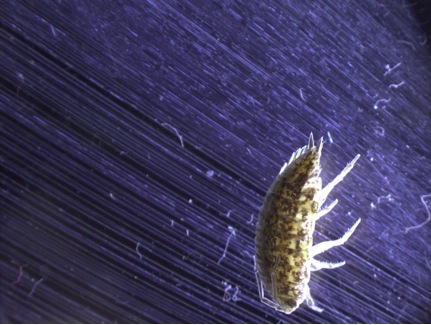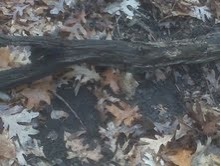Sowbug
Contact
Katharine Ordway Natural History Study Area9550 Inver Grove Trail Inver Grove Heights, MN 55076 651-455-6204 (On Site)
651-696-6230 (On Campus)
andersonm@macalester.edu
Biotic Inventory: Documenting Diversity at the Katharine Ordway Natural History Study Area
Armadillidium

Taxonomy
One organism in the vast biodiversity of the Katherine Ordway Natural History Study Area is the common pill bug, which includes a huge diversity at the species level, but is of the genus Armadillidium. Other common names for this animal include “sow bug,” “rolly polly” and “woodlice.”1
Armadillidium is in the animal kingdom and the full Linnaean taxonomy is as follows1:
Kingdom – Animalia
Phylum – Arthropoda
Subphylum – Crustacea
Class – Malacostraca
Superorder – Peracarida (Isopods and Amphipods)
Order – Isopoda
Suborder – Oniscidea (Woodlice)
Family – Armadillidiidae
Genus – Armadillidium
Species – (too diverse)
Diagnostic Characteristics
Armadillidium has unique diagnostic characteristics from other bugs found in the Ordway Study Area, since it actually is a crustacean. The following characteristics describe the genus and not the species, however, because there is no sure way to determine the exact species out of the large diversity of the Armadillidium genus based on morphological data alone. One thing to note is that the most common species of Armadillidium in Europe and North America is Armadillidium vulgare, which is the common woodlouse. Therefore, pill bugs found at the Ordway Study Area are most likely Armadillidium vulgare, but more information—such as genetic data—would be needed to make a definite conclusion.
Diagnostic characteristics:
• Armadillidium’s behavior makes it mistakable for an insect, but a quick count of its legs reveals that it has seven pairs, ruling out it being an insect.
• Armadillidium have three main body parts: the head, thorax and abdomen
• A closer look reveals that Armadillidium has an exoskeleton, a segmented body plan and antennae, which makes it easy to identify as an arthropod.
• Armadillidium do not have a waxy cuticle to prevent evaporation like some arthropods, so they are restrained to moist environments
• Identification of the genus is loosely based on the size of Armadillidium—around 15 mm—compared to other Isopods
• A more detailed diagnostic of Armadillidium is the trapezoidal shape of the last body segment2
Ecology
The geographic range of Armadillidium is vast. It is widespread in Europe and North America and is being introduced worldwide.3
The habitat of Armadillidium is damp areas, as it needs a moist environment for its modified lungs, called pseudotrachea, to function. The specific location of an Armadillidium’s burrow can vary greatly, from underneath a damp stone to the basement of a building.3
The necessity of moist conditions for respiration influences Armadillidium’s behavior, as it stays in its burrow during the day to preserve water. The lack of a waxy cuticle also forces Armadillidium to employ water-saving strategies. This means that Armadillidium are active at night.3
Other behaviors of Armadillidium lie in the family structure. The father has authority within the living arrangement and he also guards the burrow from potential threats. The mother and father gather food together to provide for the whole family. After eating, every member of the family assists with removing fecal pellets from the burrow and placing near the entrance.3
Due to its habitat of moist areas under stones and bark, Armadillidium is omnivorous and usually eats moss, fungi, algae or other decaying organic matter.4 In this way, the role of Armadillidium in an ecosystem is to decompose dead plants and animals. Its feeding habits are flexible, though, as it can switch from a vegetarian into a scavenger during a drought.3
One way that Armadillidium interacts with other organisms is the defense mechanism it employs when it is hunted. It curls up into a tight ball so that it is encased in its exoskeleton to protect its soft, vulnerable underside from predators. Some species secrete a chemical that wards off spiders.3
Another defense mechanism in some species is their coloration. The European pillbug has markings that resemble the European black widow. Animals usually avoid this poisonous arachnid, so then predators avoid Armadillidium, since it resembles the deadly spider.5
Life History
It takes Armadillidium about one year to reach sexual maturity. While they are juveniles, pillbugs molt their hard exoskeleton at regular intervals, as they outgrow it. Once they are sexually mature, they continue to molt, though they do so much less frequently. Also, mature Armadillidium molt in two stages.6
The first stage is the rear half of the body molting, and then the front half follows suit two or three days later. This window between molts is the only time that female pillbugs can have their eggs fertilized.5
In contrast to most crustaceans, Armadillidium reproduce on land instead of in the water. Individuals mate year-round, but are most sexually active in the spring. Fertilized eggs develop in a structure called a brood pouch, which is an area filled with fluid to support the embryo.3 The brood pouch is located on the underside of a female’s abdomen and a single brood may have as many as 200 eggs.7
The eggs hatch inside the pouch after three to seven weeks, and then the offspring remain in the pouch an additional seven weeks, so that offspring are fully developed before they are released from the pouch.8 Females can produce one or two broods, depending on their size and environmental conditions. If females are excessively hydrated, for instance, it causes stress on the body, preventing multiple broods. Conversely, if food is in short supply, double broods are more likely.3
In terms of reproduction, Armadillidium is semi-annual, meaning that it can reproduce multiple times per year (up to five times in some species). Females in this genus are iteroparous, since they reproduce twice or more in their life. The life cycle of Armadillidium is bivoltine, as two generations are produced per year, on average.9
The life expectancy of Armadillidium varies between species. The average age length is two or years, though some live as long as five years.4
Distribution
Armadillidium are native to Europe but were introduced as a pest to North America and are now highly prevalent on both continents. Some species have been found in North Africa, as well.3
Voucher Information
An Armadillidium individual was collected at the Ordway Study Area and was found near the base of two trees. It was in the soil underneath the leaf litter. The site of collection is pictured below.

Works Cited
1. “ITIS Standard Report Page: Armadillidium Vulgare.” Integrated Taxonomic Information System. Web. 03 May 2010. <http://www.itis.gov/servlet/SingleRpt/SingleRpt?search_topic=TSN&search_value=93250>.
2. “Species Armadillidium Vulgare – Woodlouse – BugGuide.Net.” BugGuide.Net. Web. 03 May 2010. http://bugguide.net/node/view/94180.
3. Brown, C. 1999. “Armadillidium vulgare” (On-line), Animal Diversity Web. Accessed April 30, 2010 at http://animaldiversity.ummz.umich.edu/site/accounts/information/Armadillidium_vulgare.html.
4. “Armadillidium: Facts, Discussion Forum, and Encyclopedia Article.” AbsoluteAstronomy.com. Web. 03 May 2010. http://www.absoluteastronomy.com/topics/Armadillidium.
5. “Pillbugs and Woodlice: Isopoda – Behavior and Reproduction.” 2010. Web. 1 May 2010. <http://animals.jrank.org/pages/1828/Pillbugs-Slaters-Woodlice-Isopoda-BEHAVIOR-REPRODUCTION.html>.
6. “Order Isopoda – Pillbug – Armadillidium Vulgare.” North American Insects and Spiders. Web. 03 May 2010. <http://www.cirrusimage.com/isopoda_pillbug.htm>.
7. “SowBug, PillBug or Potato Bug | How to Control, Get Rid Of, Fumigate, Eliminate, Eradicate, Kill, Get Rid Of, or Exterminate – in Toronto, Mississauga & Vaughan.” QPM | Pest Control, Fumigation and Extermination for Toronto, Mississauga & Vaughan. Web. 03 May 2010. <http://www.qpm.ca/Pests/SowBug_PillBug.html>.
8. “PNNL: Science & Engineering – What about Pillbugs?” PNNL: Science & Engineering Education Website. Web. 03 May 2010. <http://science-ed.pnl.gov/pals/resource/cards/pillbugs.stm>.
9. Hamaied S., Charfi-Cheikhrouha F. Life cycle and Population dynamic of Armadillidium pelagicum Arcangeli, 1955 (Isopoda, Oniscidea) at Aouina (2004) Comptes Rendus – Biologies, 327 (4), pp. 343-352.
Compiled by Mike Snavely.
Biodiversity & Evolution (BIOL 270) Professr Sarah Boyer. Spring 2010.
Specimen collected at Macalester College’s Katharine Ordway Natural History Study Area on April 15, 2010.